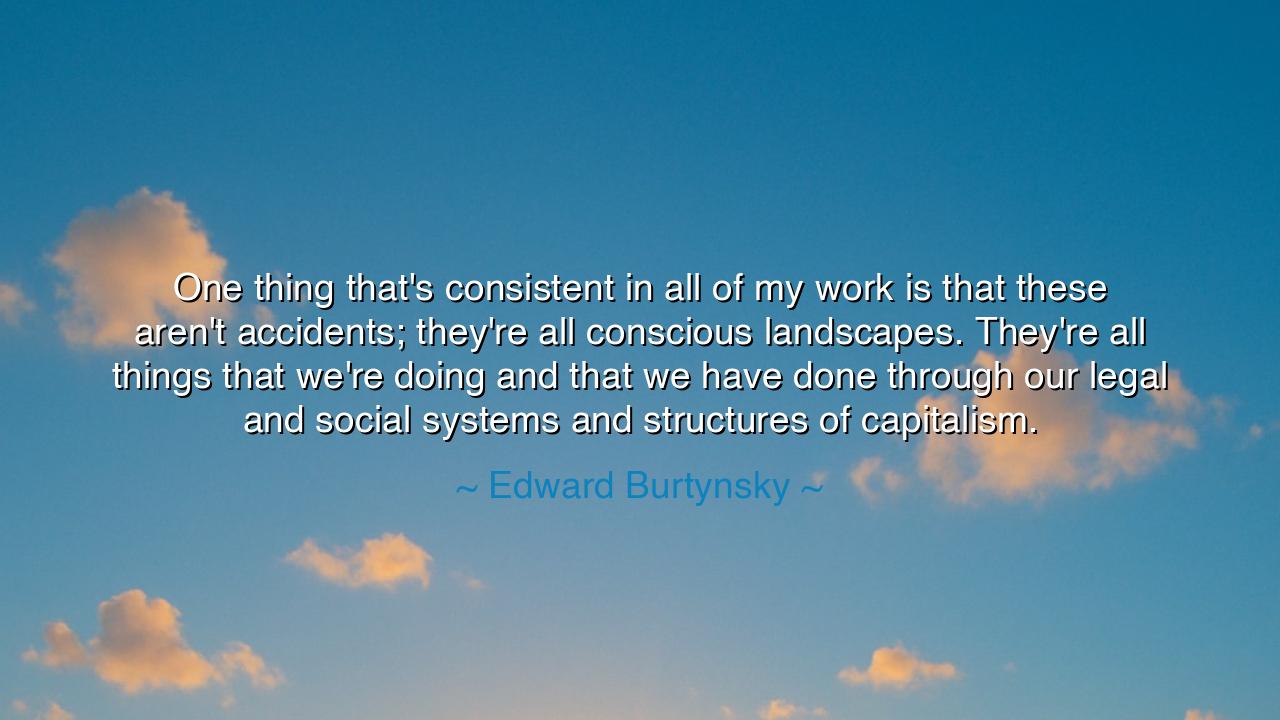
One thing that's consistent in all of my work is that these
One thing that's consistent in all of my work is that these aren't accidents; they're all conscious landscapes. They're all things that we're doing and that we have done through our legal and social systems and structures of capitalism.






"One thing that's consistent in all of my work is that these aren't accidents; they're all conscious landscapes. They're all things that we're doing and that we have done through our legal and social systems and structures of capitalism." Thus spoke Edward Burtynsky, the artist of industry’s face, whose camera has unveiled the scars of the earth shaped not by nature, but by the hands and choices of humankind. His words remind us that what we behold in his images—vast mines, endless oil fields, rivers poisoned and forests felled—are not calamities born of chance, but deliberate creations, guided by law, society, and capitalism.
The origin of this wisdom lies in the recognition that every great structure of the modern world—roads, factories, cities, and dams—emerges not from randomness but from decision. Through parliaments and congresses, through markets and contracts, through the invisible hand of capitalism and the very visible hand of law, men and women shape the earth to suit their desires. The landscapes that Burtynsky captures are monuments not of accident, but of intention: the workings of a global system that bends rivers, razes mountains, and alters the climate itself.
Consider the history of the Tennessee Valley Authority in the United States. In the 1930s, this vast project dammed rivers, flooded valleys, and transformed the land into a network of reservoirs and power plants. To some, it was salvation—bringing electricity, jobs, and prosperity. To others, it was loss—the drowning of ancestral homes, the erasure of landscapes once beloved. Burtynsky’s words echo in such stories: these were conscious landscapes, shaped by law and state, by human design, not by chance. The earth itself bore the mark of human ambition.
In his warning lies both sorrow and heroism. For if these altered landscapes are deliberate, then so too are their consequences. The melting glaciers, the spreading deserts, the oceans choked with plastic—all are not the work of blind fate, but of deliberate systems we have built. And yet, therein lies hope as well: what has been made by human hands can also be remade, redirected, reimagined. If the structures of capitalism and law can carve wounds, they can also cultivate healing.
Burtynsky’s words are also a rebuke to complacency. Too often we say, “This is the way of the world,” as though the mines dig themselves, as though forests vanish by accident. He reminds us that the world we see is the result of choices—choices written into law, justified by custom, and sanctified by profit. If destruction has been chosen, then responsibility cannot be denied. And if responsibility is acknowledged, then transformation remains possible.
The lesson is clear: awaken to the power of human agency. Do not believe that the world’s wounds are acts of fate; they are the sum of our systems, our economies, our laws. And because they are our doing, they can also be undone, or at least lessened. To accept them as inevitable is to surrender; to see them as deliberate is to claim the power of change.
What practical steps must we take? Examine the legal systems that allow exploitation without care, and demand reform. Question the structures of capitalism that prize short-term profit above long-term survival, and shape them toward sustainability. Support art, education, and voices like Burtynsky’s that reveal the hidden costs of our landscapes. And in daily life, choose consciously: for every act of consumption, every vote, every law, every policy, adds its thread to the tapestry of the world we are weaving.
So let Burtynsky’s words echo in our hearts: these are not accidents. The landscapes of industry, both wondrous and terrible, are our creation. And in that truth lies both our shame and our hope—that if we have shaped the world into this, then we, too, may yet shape it into something better, something just, something that honors the earth and those who dwell upon it.






AAdministratorAdministrator
Welcome, honored guests. Please leave a comment, we will respond soon